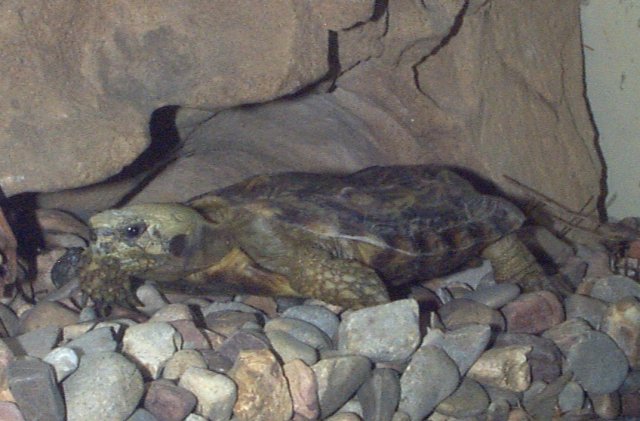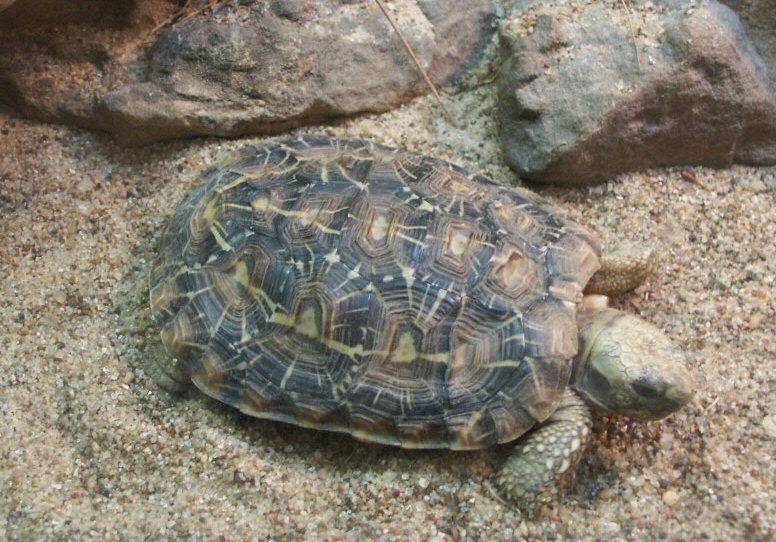|
 |
Scientific Name: Malacochersus
tornieri |
| Geographical Range: Southern Kenya and
Northern and Eastern Tanzania |
| Habitat: Rocky hills, outcrops in arid
scrub and savanna. Altitudes from 100 to 6,000 feet. |
| Diet in the Wild: Herbivores, feed mostly
on grass and fallen fruits. |
| Diet in the Zoo: Fed fruit salad and lettuce. Emerge
to eat in early morning hours. |
| Conservation Status: Not protected. |
| Location in the Zoo: Herpetarium |
|
|
| Physical Description:
Pancake tortoises are small and flat with a thin, flexible shell. The
shell is normally 6 to 7 inches long and an inch or so high. On the
legs, they have bigger scales with points that project downward and
outward.
Usually the shell has radiating dark lines on the carapace (upper part
of the shell). The plastron (bottom part of shell) is also pale yellow
but with dark brown seams and light yellow rays. Juveniles have pale
yellow top shells with black seams and yellow rays. Some may have brown
spots on their back. The carapace of juveniles is more domed than that
of adults.
Males can be distinguished from females by their larger and longer
tails; However they are smaller than the females and have less distinctive
patterns on their shell. |
Social Organization::
Pancake tortoises live in colonies but the colonies are usually isolated
from each other. Within one habitat they coexist and many individuals
may share the same crevice amicably. Males may fight during the breeding
season in January and February.

Personal observations:
You may need to visit the Herpetarium several times to catch this animal
out of its hiding place.
|
Special Adaptations:
The pancake tortoise is adapted to fitting into tight crevices. Even
larger individuals are less than 2 inches high. The shell is so thin
and flexible that the plastron moves in and out when the animal breathes.
Since the tortoise ould easily be torn apart by predators, it relies
on its speed and flexibility to escape from dangerous situations. With
the reduced weight of the shell, it can move much more quickly than
other species.
It was once thought that it could puff its body up with air to wedge
itself in place, but this has been found not to be true. Instead, it
orients its spiky legs outward so that it is almost impossible to dislodge.
Also this animal can also climb vertically. Because they are so light
they can turn themselves over with ease if they fall on their backs. |
Reproductive Behavior:
In the wild breeding is in January-February with nesting in July-August.They
lay eggs that are about two inches long. The eggs can incubated at about
30 degrees Celsius for 140 to 190 days. Combat between males prior to
breeding can lead to better reproductive success. In captivity
breeding can be any time of the year. Captive animals can live 25 years
and perhaps longer.
|
Page Author:
Tiffany Garcia and mail to:
tiffanye1984@yahoo.com
Sources and Links:
Connor, Michael J. Pancake Tortoise, Malacochersus tornieri.
Tortuga Gazette 28(11): 1-3, November 1992. <http://www.tortoise.org/archives/malaco.html>.
Kirkpatrick, David T. Ph. D. The Pancake Tortoise. Reptile
& Amphibian Magazine, May/June 1993 1-3. <http://www.unc.edu/~dtkirkpa/stuff/pancake.html>.
Dr. h.c.Grzimek, Bernhard Grzimek's Animal Life Encyclopedia 6
Reptiles. Van Nostrand Reinhold Company. New York: New York 1975.
101-102.
Honolulu Zoo. African Pancake Tortoise. 4 October 2002. <http://www.honoluluzoo.org/african_pancake_tortoise.htm>. |
|
|
|
